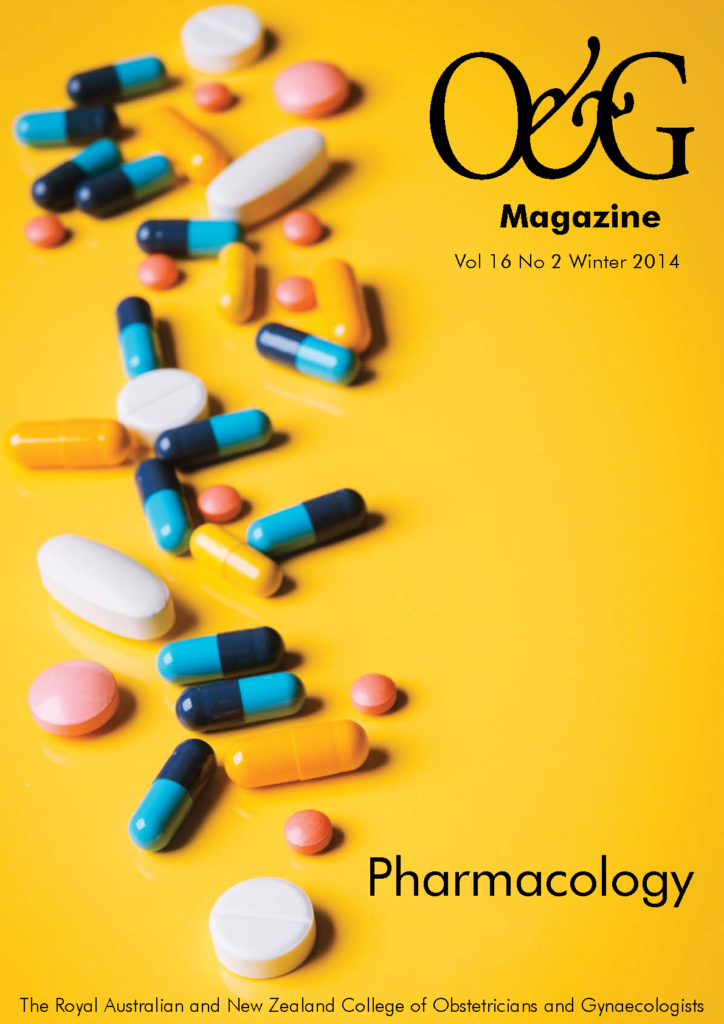A brief outline of the anti-emetics that can be used for the treatment of hyperemesis gravidarum.
Nausea and vomiting of pregnancy is a common medical condition, occurring in about 85 per cent of all pregnancies. The severity can range from mild to severe, beginning between four and nine weeks and worsening between seven and nine weeks; however, up to 15 per cent of women will experience symptoms beyond 16 weeks.
Nausea and vomiting in pregnancy, regardless of severity, can have a negative impact on the overall wellbeing of pregnant women, affecting family, work and social life. The impact on quality of life is global. Women describe feelings of isolation, fatigue, helplessness, depression, anxiety and frustration. Up to 70 per cent feel their parenting abilities are affected. Therefore, it is very important to treat this condition effectively to improve the quality of life of these women.
Clinicians looking after these women are often unsure how to treat them, fearing the use of pharmacologic therapies, owing to the concerns of potential risks to the fetus. Women using anti-emetics as a rule have a better delivery outcome than other women, probably thanks to the effect of a well-functioning placenta. However, severe untreated hyperemesis can be associated with risk to the pregnancy.
Many drugs have been successfully used for the treatment of hyperemesis and are safe and effective. Greater dissemination of this knowledge may enable more women to be effectively treated by their primary clinicians and perhaps reduce referrals to emergency departments and the need for hospitalisation and the resultant anxiety. In this article we review the safety of the common drugs used in this condition.
Dietary advice, reassurance about the wellbeing of the baby, avoidance of triggers and non-pharmacologic interventions such as acupressure are good first-line measures. If these are not successful the following drugs should be considered as additional therapy.
Metoclopramide
Dose 10mg six-to-eight-hourly oral/IV/IM. Ideally, 30 minutes before a meal.
As a stomach motility agent, it may be helpful for those women who suffer from heartburn and indigestion. No evidence of embryo, fetal or newborn harm has been found in human and animal studies. In large cohort studies, metoclopramide during the first trimester of pregnancy did not result in a significant increase in risk of major congenital malformations, miscarriage or stillbirth compared with non-exposed infants. In the largest of these studies, more than 45 000 fetuses were exposed to a median of 40 doses of metoclopramide in utero, beginning at a median gestation of 57 days. Metoclopramide has been used during all stages of pregnancy.
Antihistamines
These are the oldest class of drugs used for the treatment of nausea and vomiting and work by two separate mechanisms: they directly inhibit the action of histamine at the histamine1 receptor and indirectly affect the vestibular system. These mechanisms combine to decrease stimulation of the vomiting centre. Additionally, it has been proposed that muscarinic receptor inhibition could contribute to antihistamine antiemetic activity.2 Commonly used antihistamines are cyclizine and promethazine. Others include mecilizine, dimenhydrinate and diphenhydramine. There is no data on using the scopolamine patch for nausea and vomiting of pregnancy.4 The safety of antihistamines (specifically H1 receptor blockers) was affirmed in a meta-analysis that examined the association between antihistamine use and major malformation. This review of 24 controlled studies, including over 200 000 first trimester exposures, found that H1 receptor blockers appeared to have protective effect on risk of malformations (OR 0.76, 95 per cent CI 0.60-0.94). An association between exposure during the last two weeks of pregnancy to antihistamines and retrolental fibroplasias in premature infants has been reported.3
Cyclizine
Dose 25–50mg eight-hourly oral/IV.
This is a piperazine antihistamine. In 111 patients given cyclizine in the first trimester, no increased malformation was observed.3
Prochlorperazine
Dose 5–10mg oral/IV/IM six-hourly or 25mg PR twice daily.
This is a dopamine antagonist, Dopamine 2 receptors are implicated in emetic signalling through the chemoreceptor trigger zone.
Although there are isolated reports of congenital defects of children exposed to prochlorperazine in utero, the majority of the evidence indicates that this drug and the general class of phenothiazines are low risk for both mother and fetus if used occasionally in low doses.3
Ondansetron
Dose 4mg oral/IV six-hourly.
This is a selective serotonin 5-HT3 receptor antagonist known for its use in treating chemotherapy-related nausea and vomiting. Safety data have increased over the past few years, together with a relaxation of regulations about prescription in New Zealand, hence it is commonly used despite the cost.1 A randomised double blinded trial was conducted comparing IV ondansetron with IV promethazine for the treatment of hyperemesis gravidarum. No difference was observed between the groups in terms of duration of hospitalisation, nausea score, number of doses received, treatment failures and daily weight. The only adverse effect was sedation in the promethazine group.
Two studies (Einarson et al, 2004 and Asker et al, 2005) found no association between the use on ondansetron and major birth defects, but their sample sizes were small. Anderka et al 2012 showed that their study concurred with the data except for cleft palate, for which a doubling of odds was observed.
Animal data on ondansetron are reassuring as to its safety in pregnancy. Human data on safety or efficacy for treatment of hyperemesis are based on case reports, small series and a historical cohort of 849 women in Denmark, exposed during pregnancy. In this large record linkage study, ondansetron was not associated with an increased risk of major congenital anomalies, miscarriage, low birth weight or small for gestational age babies when used for treatment of nausea and vomiting of pregnancy.3
This drug is now very popular with women owing to its effectiveness as well as its availability as a dispersible tablet (wafer form). However, it has a side effect of constipation and patients should be cautioned about this so that steps may be taken to combat it.
Owing to its cost, clinicians should consider alternatives before prescribing ondansetron, bearing in mind that there is benefit in preventing admission to hospital. Ondansetron is available on a three-month supply from retail pharmacies if prescribed by a specialist O and G and annotated that it is for hyperemesis.
Pyridoxine (Vitamin B6)
Dose 25–50mg orally eight hourly.
Is used as a first line in many countries for nausea and vomiting in early pregnancy, however, there are large individual differences in its onset and action. Studies have shown it improves mild to moderate nausea, but does not improve vomiting. In the USA it is used in combination with doxylamine, an antihistamine, and the FDA, in April 2013, approved this combination for the use in pregnancy as there are no risks to the developing fetus.
Adjunctive therapy
Acid-reducing agents
Antacids containing aluminium or calcium are safe in pregnancy and preferable to those containing bismuth or bicarbonate, which may have adverse fetal/neonatal effects. Most experience with pharmacologic acid suppressive therapy in pregnant women has been with the H2 receptor antagonists ranitidine and cimetidine, which appear to be safe in pregnancy.4
Vitamins and minerals
If the woman is experiencing vomiting, it is important to replenish low levels of vitamins (especially thiamine), electrolytes and minerals. Thiamine supplementation is with 50mg daily once a day.
Iron deficiency is problematic to treat in this context, if there is concern about anaemia then iron infusion may be considered past the first trimester.
Glucocorticoids
To be considered in severe hyperemesis. The mechanism is unclear and there is paucity of evidence that they are effective and there may be a small teratogenic risk.
Local guideline
A national women’s hospital in Auckland has developed a guideline for the management of hyperemesis in pregnancy, based on the evidence and effectiveness of drugs, as well as cost considerations (available online at: http://nationalwomenshealth.adhb.govt.nz/Portals/0/Documents/Policies/Hyperemesis_.pdf). It covers the clinical assessment, investigations and management of hyperemesis, including the use of IV fluids and drugs. This ensures a standardised and rational approach with consistency of care for women. It is instituted at admission to the acute gynaecology area and includes a discharge plan. It encompasses a multidisciplinary approach that encourages the input of a dietician, social worker, physiotherapy and, in the case of intractable hyperemesis, an obstetric physician.
The guideline recommends metoclopramide is used as a first-line agent. Second-line agents are cyclizine, prochlorperazine and ondansetron. All women are prescribed folic acid (5mg), iodine (150μg), pyridoxine (50mg daily) and thiamine 50–100mg orally daily, or intravenously if thought to be at risk of Wernicke’s encephalopathy.
Thromboprophylaxis is an important consideration as these women are at a greater risk, owing to dehydration and general reduction in activity.
Discharge planning is emphasised, to prevent readmission. A regime that is sustainable at home must be in place and effective prior to discharge. We believe this has led to safe, effective and holistic care of our women.
Although nausea and vomiting of pregnancy is a self-limiting condition, it is important that, as clinicians, we prescribe safe and effective medication for the women in our care and help them regain a good quality of life while in their first trimester of pregnancy and, for some, throughout their pregnancy.
References
- Donald R Mattison. Clinical Pharmacology During Pregnancy.1st ed. London U.K:Elsevier; 2013.
- Gill SK, Einarson A. The safety of drugs for the treatment of nausea and vomiting of pregnancy. Expert Opin. Drug Saf.(2007) 6(6): 685-694.
- Asker C, Nordtedt Wikner B, Kallen B. Use of Antiemetic Drugs during pregnancy in Sweden. Eur J Clin Pharmacol. 2005 Dec;61(12): 899-906.Epub 2005 Nov 18.
- Briggs GG, Freeman RK, Yaffe SJ. Drugs in pregnancy and lactation.9th ed. Wolters Kluwer: Lippincott Williams & Wilkins; 2011; 1077-1078.
- Smith J, Lockwood CJ, Barss VA. Treatment and Outcome of Nausea and vomiting of pregnancy. Copyright 2014 UpTo date available from www.uptodate.com/contents/treatment-and-outcome-ofnausea-and-vomiting-of -pregnancy .
- Seto A, Einarson T, Koren G. Pregnancy Outcome following first trimester exposure to antihistamines. Meta analysis. Am J Perinatology. 1997;14;119.
- Sullivan CA, Johnston CA, Roach H, Martin RW, Stewart DK, Morrison JC. A Pilot study of Intravenous Ondansetron for hyperemesis gravidarum. Am J Obstet Gynecol. 1996;174:1565-8.
- Anderka M, Mitchell A, Louik C,Werler M et al and the National Birth Defects Prevention Study. Medications used to treat nausea and Vomiting of pregnancy and the risk of selected birth defects. Birth defects research (part A ): Clinical and Molecular Tetraology. 2012; 94: 22-30.
- Nausea and Vomiting in pregnancy. Best Practice Journal. 2011: 40 (24-9).
- Fantasia HC. A new pharmacologic Treatment for Nausea and vomiting of pregnancy. Nursing for Women’s Health. 2014 Feb/Mar; Issue 1; 73-7.
- Magee LA, Mazzotta P, Koren. Evidence Based View of safety and effectiveness of pharmacologic therapy for nausea and vomiting of pregnancy. Am J Obstet Gynecol. 2002 May ;186(5 Supple Understanding ):S256-61.







Leave a Reply